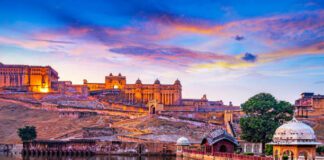Elephanta Caves, nestled on an island 8 km from Mumbai, have captivated explorers and scholars since the sixteenth century. This article embarks on a journey to consolidate historical accounts, shedding light on the mysteries that enshroud these ancient rock-cut wonders.
Historical Prelude: Naming Conundrum
The isle’s nomenclature dances through various renditions—Pory, Elephanta, Gali Pouri, Garapuri, or Gharapuri. The locals, however, recognize it as Gharapuri, showcasing the rich tapestry of linguistic interpretations.
Earliest Glimpses: Travelers’ Musings (16th Century)
Garcia de Orta, a Portuguese physician (1534), alludes to a subterranean abode adorned with sculptures of elephants, lions, and enigmatic human forms. Joao de Castro (1538) marvels at the quality of craftsmanship, attributing it to a Hindu king, Banasur. Early explorers, like Diogo de Couto and Gasparo Balbi, grapple with the cave’s origins, suggesting Chinese involvement or even linking it to Alexander the Great.
European Intrigue and Interpretative Struggles (17th Century)
John Fryer (1673) and J. Ovington (1689) contribute fleeting references, while Captain Pykes (1712) delves into specifics, pinpointing a stone elephant and a horse on the island. Pykes unfolds the marvels of the main cave, speculating on its builders—perhaps Egyptian artists or the Chinese. These narratives, a blend of awe and interpretative struggles, weave a tale of cultural confluence.
Deciphering the Unseen: 18th-Century Explorers
The 18th century witnesses varied accounts by English doctor John Henry Grose (1750), who likens Elephanta’s grandeur to the Great Pyramids, and Alexander Hamilton (1744), who muses on the stone elephant’s lifelike semblance. Grose bemoans the Portuguese-inflicted mutilation, while Hamilton remains intrigued by the enigmatic sculptures.
Anquetil du Perron (1760) and Carsten Niebuhr (1764), French and German scholars respectively, add depth with attempts at analysis. Niebuhr lauds the sculptures’ elegance, hinting at India’s underestimated artistic legacy. However, the ignorance of locals frustrates him, reflecting a recurring theme in Elephanta’s narrative.
Culmination of Contradictions: Late 18th Century
Hector Macneil (1783) and William Hunter (1784) grapple with contradictions. Macneil, after visiting Kanheri and Jogeshwari, decries the mutilation by zealots, and Hunter offers meticulous measurements but wrestles with attributions to Egyptians or Gentoos (Hindus).
Goldenham’s Enlightenment: Late 18th Century
J. Goldenham (1799) brings Hindu iconography to the forefront. He identifies the Trimurti in the main cave, dismisses the Solomon theory for Andhakantaka-murti, and designates the cave a Hindu shrine devoted to Shiva. His insights mark a turning point in Elephanta’s interpretation.
Legacy and Unanswered Questions
The legacy of Elephanta Caves persists, an eternal dance between historical accounts and the elusive truth. Despite the meticulous observations of these early explorers, the origin and builders remain shrouded in mystery. As we tread the path laid by these intrepid voyagers, Elephanta Caves stand testament to the intersection of cultures and the enigma that endures through centuries.
In the echo of ancient sculpted walls, Elephanta beckons, inviting contemplation on the intersections of history, art, and the inscrutable allure of the past.









